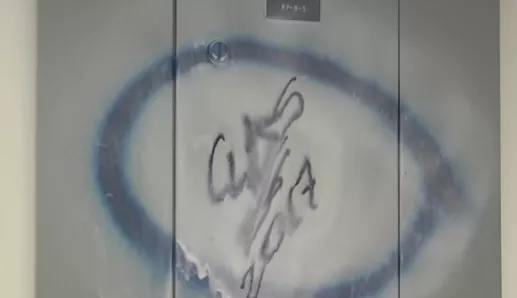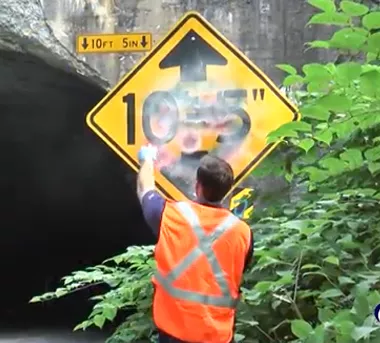Graffiti artists present a conundrum. While we want to support rebel artists in their fight against “the man”, we also want them to keep their annoying tags off our garage door.
However, when a vandal strikes with his spray can of paint, you need to be resourceful—then apply some elbow grease.
Is that too much to ask? Nobody’s home looks better with a giant squiggle in the middle of the garage door. It’s an eyesore, at the very least, and it wins no love from the neighbors.

Homeowners in both the city and the ‘burbs dread a graffiti attack. Taggers don’t limit their practice to urban areas, like they did in the 1970s. Now they ride the commuter trains and expand their outdoor canvas to the bedroom communities.
If your garage door got a hostile makeover from a tagger, there are boutique companies who specialize in cleaning it off. But it will cost. If you’d rather spend your disposable income elsewhere, here are some DIY solutions, as well as some tips for success.
Spray it away
Before investing in a war chest of chemicals to clean your door, try using a pressure washer. It’s like a turbo-powered garden hose. They can be rented at home renovation stores, or borrowed from your brother-in-law. If you’re lucky, the power hose might wash away the problem.
But keep the four important “ifs” in mind:
- If your door is sealed with a stain or made of treated wood, begin by soaking a soft cloth with a liquid cleaner. Next, applying the cloth to the graffiti. Let it soak in for 5 to 10 minutes. Standing two feet from the door, start straying with a medium pressure at the top of the door and work down methodically.
- If that isn’t removing the graffiti, try a stronger cleaning product—something powdered, with an abrasive quality. Next, graduate to mineral spirits, bleach (1:4 ratio with water), then diluted paint thinner. Still no results? Then it’s time to invest in a more professional, commercial‑grade graffiti removal product. They usually contain methylene chloride, a high‑powered solvent used by graffiti removal companies. Some are semi‑gel for easier application on vertical surfaces.
- If you’re environmentally conscious, try the most lauded “green” cleaning recipe: white vinegar mixed with lemon juice, or white vinegar and baking soda. Apply it with a toothbrush and let it sit for 20 minutes before rinsing with the power hose.
- If your garage door is aged or made of untreated wood, use light water pressure or else the force of the water will drive the paint deeper into the wood. Test a small area. If it’s not working, switch tactics: apply a gentle cleaning product using a thick brush, like a wallpaper paste brush, or a plush paint roller, then wipe by hand. It will take more time, but it will save your wood from having a ghost image of the graffiti. Still not clean? Invest in a low‑volatility solvent that quickly penetrate and dissolves graffiti while minimizing the potential damage to the underlying surface.
Not all paints are created equal
Graffiti artists can be loyal to their favorite paint—often the cheapest, making them the easiest to remove—but there are many different kinds of liquids and strays out there.
Your tagger could’ve used enamel, varnish, polyurethane, vinyl, acetates and alkyds paint, or permanent markers. Determining the kind of spray paint on your door will help you buy the right cleaning product to use with the power washer or by hand.

Know your door
An antique stable door from 1898 will not react the same to graffiti as a factory‑made garage door with baked‑on paint. The latter is much more resistant. If your garage door was repainted in a paint shop by professionals, ask them what type of paint they used. Alternately, if you’re a DIY type, you might’ve given the door its last top coat of color and the can is still in the basement.
Metal matters
Metal doors and aluminum doors are the most resistant and hearty, when it comes to scrubbing off graffiti. First, try wiping graffiti with any household paint thinner, methanol, mineral spirits, rubbing alcohol, lacquer thinner or acetone (Yes, that nail polish remover under the bathroom sink).
Don’t worry about diluting it, but protect your hands with rubber gloves. Next, try a light penetrating oil like WD40. If you still aren’t seeing results, gently rub the area with steel or bronze wool or light sandpaper in circular motions, then power washing from a distance of two feet. Using 3000psi pressure washer and work top to bottom.
Still not working? You could need a high-performance HD stripper for paint, varnish, lacquer, enamel and other finishes. They are heavy‑duty penetrating, non‑flammable solvents on the market with evaporation barrier-forming components to assure maximum contact time, and powerful emulsifiers. Some have extra clinging power on vertical surfaces.
You can find these paint removers at a paint dealer. Let them sit of the graffiti for between 15‑30 minutes, according to instructions. This type of product is also used by companies who specialize in removing graffiti.
In all of these cases, note that if you use this type of professional-grade solvent, you can easily damage the base coat of paint on your garage door. Depending how fastidious you are about the outcome, you may need to repaint the entire door.

Plan to repaint
Instead of spending all day scouring graffiti with a toothbrush, desperately trying not to remove the door’s original layer of paint, there is a more direct approach. Concede that it’s too fiddly and opt to repaint. First, clean all the dirt, dead bugs and oil off the surface. Next, apply a primer to the entire door to blot out the graffiti and best prepare the surface to receive a new top coat.
If your door is from Garaga or is a door with a similar surface, then refer to our website for the instructions you’ll need to repaint it.
Repainting a garage door is a great opportunity to refresh your home’s overall look by coordinating the garage door with the front door. That doesn’t mean the doors have to be matchy‑matchy. Some people want their front door to “pop” by downplaying the garage door in a neutral shade, or vice versa. It’s best to keep double and triple garage doors in lighter colors.
If you’re insecure about choosing paint colors (who isn’t?), there are visualizer tools on the websites of most major paint manufacturers. These tools allow people to see a virtual mock‑up of their type of home with various exterior paint colors. It cuts down on “What was I thinking?” mistakes.
Changing your garage door
After you’ve come to terms with the graffiti situation, maybe you realize it’s time to go all out—replace your garage door. If you live near West Farmington, OH, contact us now at 330-889-0062.
We provide no‑obligation quotations by email. Or, visit our showroom and use the Design Centre to browse door styles on our image gallery. Inspiration will strike!


Add new comment